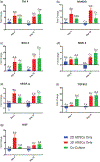Adipose-derived stem cell-secreted factors promote early stage follicle development in a biomimetic matrix
- PMID: 30608082
- PMCID: PMC6351215
- DOI: 10.1039/c8bm01253a
Adipose-derived stem cell-secreted factors promote early stage follicle development in a biomimetic matrix
Abstract
Development of primary follicles in vitro benefits from a three-dimensional matrix that is enriched with paracrine factors secreted from feeder cells and mimics the in vivo environment. In this study, we investigated the role of paracrine signaling from adipose-derived stem cells (ADSCs) in supporting primary follicle development in a biomimetic poly(ethylene glycol) (PEG)-based matrix. Follicles co-cultured with ADSCs and follicles cultured in conditioned medium from ADSCs encapsulated in gels (3D CM) exhibited significantly (p < 0.01 and p = 0.09, respectively) improved survival compared to follicles cultured in conditioned medium collected from ADSCs cultured in flasks (2D CM) and follicles cultured without paracrine support. The gene expression of ADSCs suggested that the stem cells maintained their multipotency in the 3D PEG environment over the culture period, regardless of the presence of the follicles, while under 2D conditions the multipotency markers were downregulated. The differences in cytokine signatures of follicles exposed to 3D and 2D ADSC paracrine factors suggest that early cytokine interactions are key for follicle survival. Taken together, the biomimetic PEG scaffold provides a three-dimensional, in vivo-like environment to induce ADSCs to secrete factors which promote early stage ovarian follicle development and survival.
Conflict of interest statement
Conflicts of Interest
The authors have no conflicts of interest to declare.
Figures





References
-
- Donnez J, Dolmans MM, Martinez-Madrid B, Demylle D, Van Langendonckt A. The role of cryopreservation for women prior to treatment of malignancy. Curr Opin Obstet Gynecol. 2005;17(4):333–8. - PubMed
-
- Yada-Hashimoto N, Yamamoto T, Kamiura S, Seino H, Ohira H, Sawai K, et al. Metastatic ovarian tumors: A review of 64 cases. Gynecol Oncol. 2003;89(2):314–7. - PubMed
-
- Dolmans M-M, Marinescu C, Saussoy P, Van Langendonckt A, Amorim C, Donnez J. Reimplantation of cryopreserved ovarian tissue from patients with acute lymphoblastic leukemia is potentially unsafe. Blood [Internet]. 2010;116(16):2908–14. Available from: http://www.bloodjournal.org/cgi/doi/10.1182/blood-2010-01-265751 - DOI - PubMed
-
- Meirow D, Hardan I, Dor J, Fridman E, Elizur S, Ra’anani H, et al. Searching for evidence of disease and malignant cell contamination in ovarian tissue stored from hematologic cancer patients. Hum Reprod. 2008;23(5):1007–13. - PubMed
MeSH terms
Substances
Grants and funding
LinkOut - more resources
Full Text Sources
Medical

